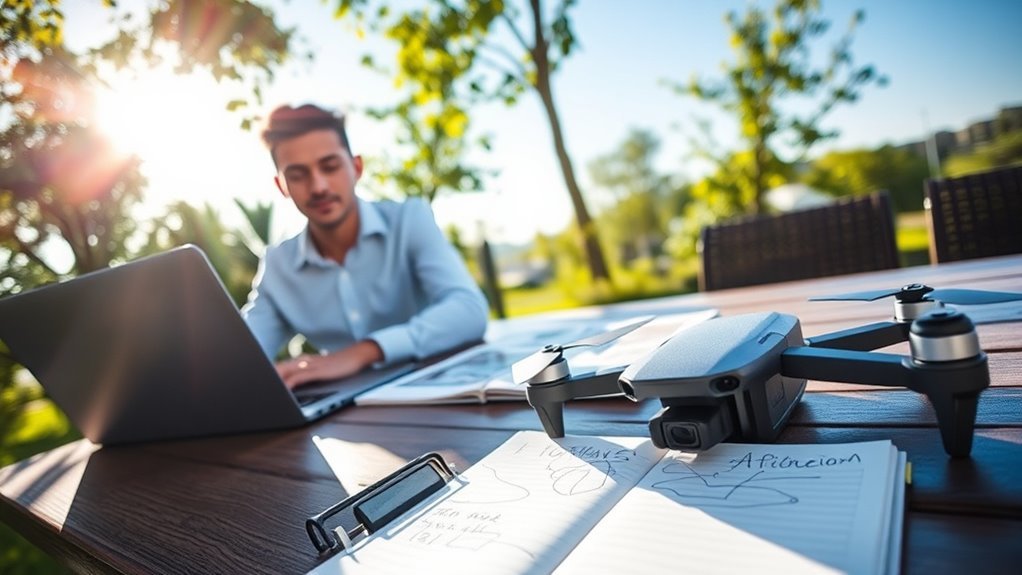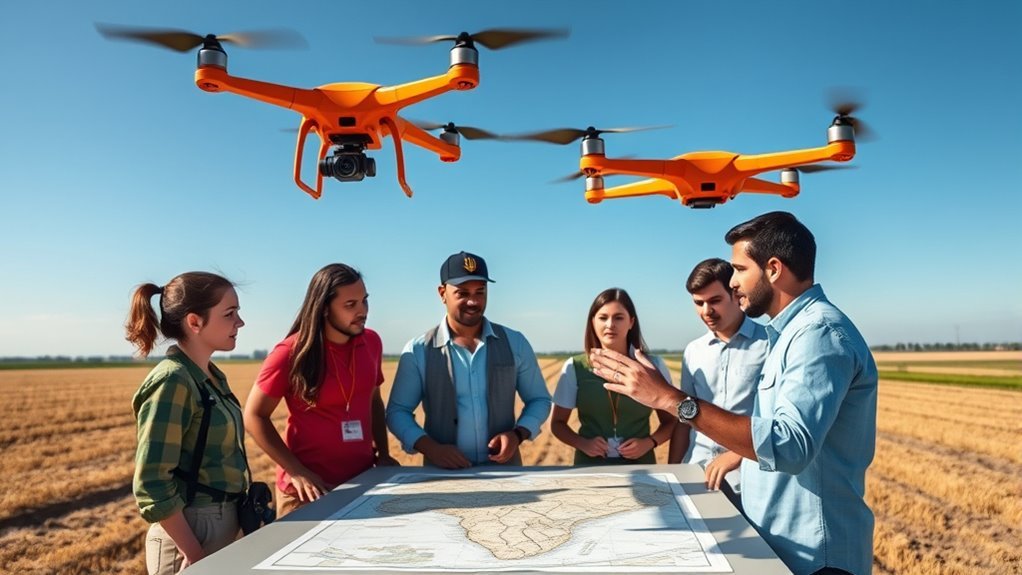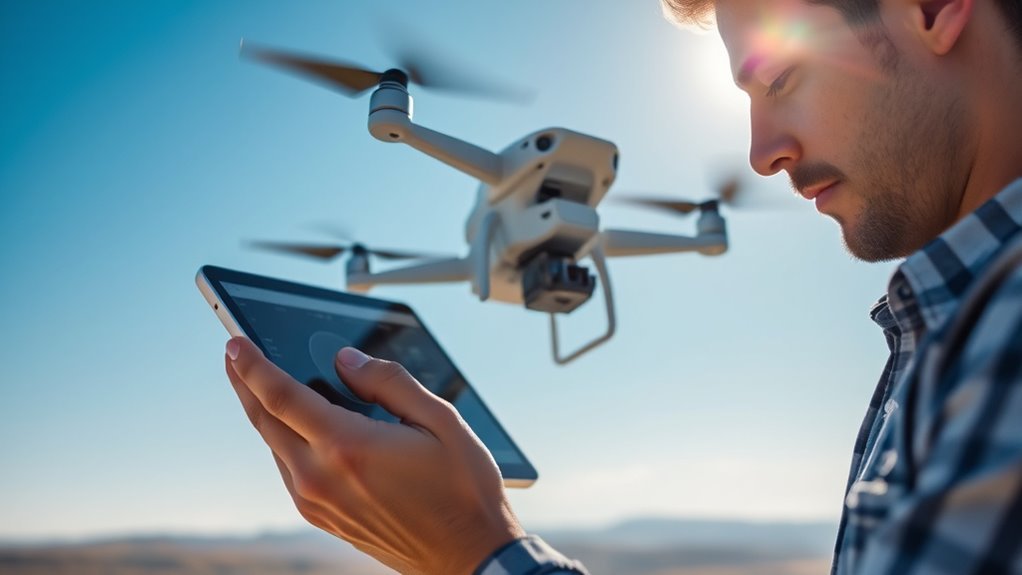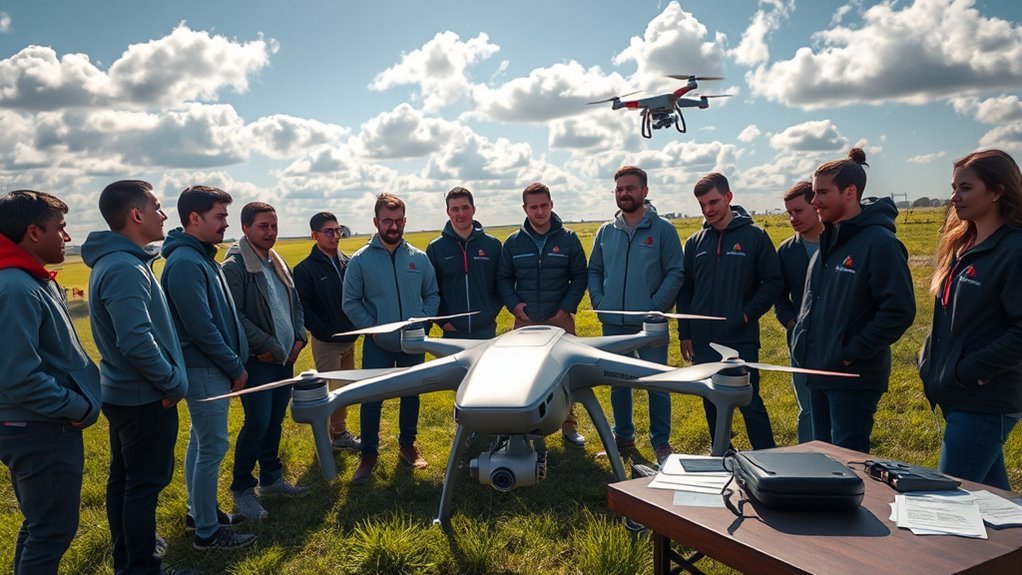To become a certified drone pilot, you’ll need to familiarize yourself with FAA regulations and local laws. Pass the FAA Part 107 exam, ensuring you meet eligibility requirements. You’ll also want practical flight experience, so consider using simulators and joining local clubs. Understanding career opportunities in areas like aerial photography and agriculture can enhance your prospects. By following these steps, you’ll be well-prepared for success in this rapidly growing field. There’s much more to explore about your journey ahead.
Understanding Drone Regulations and Requirements

Understanding drone regulations and requirements is vital for anyone aspiring to become a certified drone pilot. To guarantee drone safety, you must familiarize yourself with the Federal Aviation Administration (FAA) guidelines and local laws. Regulatory compliance isn’t just a bureaucratic hurdle; it’s a foundation that safeguards your rights as a pilot while protecting the public. You’ll need to pass the FAA’s Part 107 exam, which tests your knowledge of airspace classifications, weather, and emergency procedures. Additionally, registering your drone is important to avoid fines and legal issues. By adhering to these regulations, you can fly freely and confidently, knowing you’re part of a responsible community that values safety and respects the airspace. Embrace this journey; it’s a pathway to your freedom as a pilot.
Choosing the Right Drone for Certification

When choosing the right drone for certification, you need to assess your specific needs, ensuring the drone aligns with your intended applications. Budget considerations also play a vital role, as the right drone should offer the best balance between features and cost. Finally, understanding the technical specifications will help you make an informed decision that meets both regulatory requirements and your personal objectives. Additionally, consider drones with advanced camera capabilities to enhance your aerial photography and videography skills. For instance, drones like the DJI Mini 3 provide superior camera performance compared to many budget options.
Assessing Your Needs
How do you determine which drone best fits your certification needs? Start by aligning your personal goals with your project requirements. Consider what you aim to achieve—whether it’s aerial photography, surveying, or agricultural monitoring. Each application demands specific features: camera quality, flight time, and payload capacity. Next, research the drones that excel in your chosen field. Look for models that offer flexibility and performance to adapt to various tasks. In addition, evaluate user feedback and reviews to gauge reliability and ease of use. By thoroughly evaluating these factors, you’ll find a drone that not only meets your certification standards but also enhances your ability to pursue your passions in the skies. Choose wisely, as this decision shapes your path as a certified drone pilot.
Budget Considerations
Choosing the right drone for your certification not only hinges on features but also greatly depends on your budget. A thorough cost breakdown is essential to guarantee you’re making a wise investment. Start by evaluating the equipment expenses associated with various drone models. Basic models may suffice for entry-level certifications, but if you aim for advanced aerial applications, you might need to allocate more funds for higher-quality drones. Consider additional costs like software, batteries, and maintenance too. It’s crucial to balance your aspirations with financial limitations. By conducting diligent research on pricing and available features, you’ll find a drone that not only meets your certification needs but also fits comfortably within your budget. Make your choice wisely to guarantee your freedom in the skies.
Technical Specifications Explained
Understanding the technical specifications of a drone is vital for anyone seeking certification. The right drone can greatly impact your proficiency in drone technology and flight mechanics. Here are key specifications to take into account:
- Payload Capacity: Confirm it can carry the equipment you’ll use, such as cameras or sensors.
- Flight Time: Look for drones with longer battery life to maximize operational efficiency.
- Range: Choose a drone with sufficient range for your intended applications, balancing freedom with control.
- GPS and Sensors: Advanced navigation features enhance stability and safety, important for certification.
Preparing for the FAA Part 107 Exam

Although preparing for the FAA Part 107 exam can seem intimidating, a structured approach can greatly enhance your chances of success. Begin by creating a detailed study schedule; allocate time for each subject area, ensuring you cover topics like airspace regulations, weather, and drone operations. Utilize various resources such as online courses, practice exams, and study guides to reinforce your understanding. Implement effective exam strategies, like taking practice tests under timed conditions to simulate the real experience. This not only helps you identify weak areas but also builds your confidence. Stay focused and disciplined in your study routine, and remember that consistent effort will lead to mastery. Embrace this journey, and you’ll be well on your way to becoming a certified drone pilot.
Taking the FAA Part 107 Exam
When you’re ready to take the FAA Part 107 Exam, understanding the eligibility requirements is essential to guarantee you meet the necessary criteria. You should also gather effective study resources and tips to maximize your chances of success. By focusing on these key areas, you’ll be better prepared to achieve certification as a drone pilot.
Exam Eligibility Requirements
To become a certified drone pilot under the FAA’s Part 107 regulations, you must meet specific eligibility requirements before taking the exam. Understanding these exam prerequisites is essential for ensuring you’re prepared. Here are the key eligibility criteria:
- You must be at least 16 years old.
- You need to be able to read, write, and speak English.
- You should possess a valid government-issued ID.
- You must not have any medical disqualifications that affect your ability to operate a drone.
Meeting these requirements paves the way for you to demonstrate your knowledge and skills, giving you the freedom to explore the skies as a certified drone pilot.
Study Resources and Tips
Once you’ve confirmed your eligibility for the FAA’s Part 107 exam, the next step is to equip yourself with the right study resources and strategies. Utilizing thorough study guides can streamline your preparation, ensuring you cover all necessary topics. Look for resources that break down complex regulations and aviation principles into digestible segments. Online courses are another invaluable tool; they often provide interactive content, quizzes, and expert insights to enhance your understanding. Consider joining forums or study groups to exchange tips and experiences with fellow candidates. Remember, consistent practice with sample questions will bolster your confidence. By strategically using these resources, you’ll position yourself for success on the exam and embrace the freedom of flying drones legally and safely.
Gaining Practical Flight Experience
Although theoretical knowledge is essential for becoming a certified drone pilot, gaining practical flight experience is equally crucial for mastering the skills required to operate a drone safely and effectively. Here are four key approaches to enhance your flight practice through hands-on training:
- Simulators: Use flight simulation software to familiarize yourself with drone controls and maneuvering. Engaging with interactive missions can also improve your flight skills and understanding of drone operations.
- Controlled Environments: Start flying in open, controlled spaces to minimize risk and practice basic maneuvers.
- Join a Club: Connect with local drone clubs to gain insights, share experiences, and participate in group flying sessions.
- Real-World Scenarios: Gradually incorporate real-world conditions, such as varying weather and terrain, to enhance your adaptability. Additionally, consider investing in an entry level drone with minimum 1080p camera resolution to capture your flying progress and improve your skills.
Exploring Career Opportunities as a Certified Drone Pilot
Building on the practical flight experience gained through simulations and controlled environments, the potential career paths for certified drone pilots are diverse and expanding rapidly. You can explore commercial applications across various sectors, including aerial photography for real estate marketing, agricultural monitoring to optimize crop yields, and infrastructure inspection to guarantee public safety. Additionally, your skills can contribute to environmental research, disaster response, and wildlife conservation efforts. Surveying services in construction and land development also rely heavily on drone technology. By embracing these opportunities, you’ll not only enhance your career prospects but also engage in work that can make a tangible difference in society. The freedom to choose your path makes becoming a certified drone pilot an exciting venture. Moreover, the integration of advanced AI and autonomous systems in drone technology enhances operational efficiency and opens up even more career possibilities. As agricultural practices evolve, the demand for pilots skilled in crop geofencing and spraying safety will continue to grow.
Frequently Asked Questions
What Is the Age Requirement to Become a Certified Drone Pilot?
When you’re dreaming of soaring through the skies, age restrictions can seem limiting. To qualify for certification, you must be at least 16 years old, ensuring you’re eligible while still embracing your passion for flight.
Can I Take the FAA Part 107 Exam Online?
You can’t take the FAA Part 107 exam online; it must be done in person at an approved testing center. For success, thorough exam preparation aligned with FAA regulations is essential to demonstrate your knowledge effectively.
How Long Does the Certification Process Take?
Ever wondered how long the certification timeline really is? Typically, training duration varies, but expect a few weeks for prep, plus potential wait times for exam scheduling. Stay focused, and you’ll navigate it smoothly!
Are There Any Health Requirements for Drone Pilots?
Yes, there are health requirements for drone pilots. You’ll need to pass medical evaluations, guaranteeing you meet specific vision standards. This guarantees you’re fit to operate a drone safely, maintaining freedom in your flying endeavors.
What Are the Costs Involved in Certification?
Did you know that nearly 70% of aspiring drone pilots face unexpected costs? Certification fees can range from $150 to $300, while training expenses may add another $500–$1,500, depending on your chosen program and resources.

